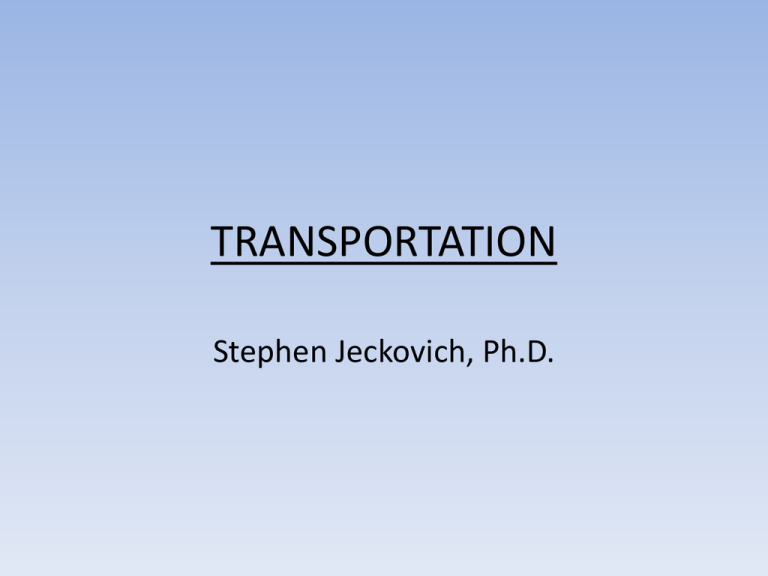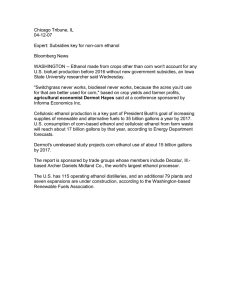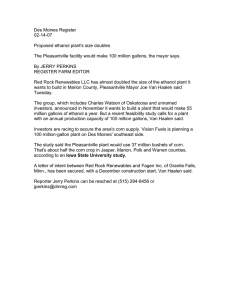Transportation by Steve Jeckovich (powerpoint)
advertisement

TRANSPORTATION Stephen Jeckovich, Ph.D. BEGINNING OF 20th CENTURY • Internal combustion engine • Henry Ford’s production of the automobile • Expanded need for gasoline, growth of US oil industry. • US oil independent CURRENTLY • Transportation (cars, trucks, buses, airplanes) energy Achilles heel • US oil dependent • Vulnerability OPEC 1 (first oil shock. Oct 1973 –Mar 18, 1974) EMPHASIS ON AUTO TECHNOLOGY • Increase mpg, decrease pollution…hybrid, fuel cells, et al • DARPA annual project: use Artificial intelligence, driverless car • Manage streets, traffic, obey traffic signs, pass, merge, military supply • Nov 2007 test in Victorville, CA-35 contestants • 55 miles of city streets • Winner: Carnegie Mellon TATA CORPARATION • Developed and built NANO car in India • Four passengers, two doors, 33 HP, max speed 60MPH, 45 mpg • Sales Price: $2500 • Sales forecast 2008 India: 200,000 cars • Consequences: Pollution, increase demand for gasoline (22 million gallons) SMART CAR • Developed by Mercedes-Benz and built in France • Two passengers, eight feet long, weight 1500# • One liter engine, 3 cylinder engine, 61 HP, 46/68 mpg, top speed 84 mph • Sacramento dealer has 22 cars • Price starts at $11,000 RECENT CONGRESSIONAL ENERGY MANDATES • Auto mileage: current 28.5/22.0 to 35 mpg by 2020 for light trucks and autos • Engineering analysis: • Requires 30% weight reduction • Plastic substitution for metal • Price increase: $3,000 to $5,000 • Raw materials supply: oil and natural gas SAFETY • Ralph Nader, 1965, “Unsafe at any speed.” • Development of safer car: side impact, roll over, front end collision, etc • Windshield accidents; concussion/cadavers. Laceration/hi speed impact sled (skin) • Safer windshield configuration (flexibility/laceration) • Seat belts, airbags ETHANOL: PANACEA OR TURKEY? • 5 billion gallons from corn, 2006, 134 plants, coal fired, located in Midwest • Increase to 36 billion gallons in 2022 • 12 billion ethanol, Generation One, corn • 24 billion ethanol, Generation Two, prairie grass, wood chips, et al • Retain import duty of $0.54 per gallon on Brazilian ethanol • Negative ethanol energy cycle = 6 x energy in auto engine (Cornell, Berkeley and others) BRAZIL SUCCESS STORY • • • • • • • 4.4 billion gallons from sugar cane, 2006 Productivity: corn = 400 gallons per acre Sugar cane = 600 gallons per acre Ethanol used in 70 % of cars Future 90% of cars will be flex fuel Why can’t we do the same? Brazil car population = 3% of US car population (big difference in scale) US ETHANOL USAGE • • • • • Usage about 3% of total gasoline Massive land coverage 5,000 gas stations sell 5 – 10% blend E85 blend in Chicago test Affecting food and cattle feed prices ETHANOL IN US FUTURE • Generation Two success depends upon adequate raw material supply, feasible and profitable process, positive energy cycle, Big bang potential • Meet energy, environmental and economic criteria • Ethanol does not appear to have big bang nor economic potential for playing a role in closing the energy gap





